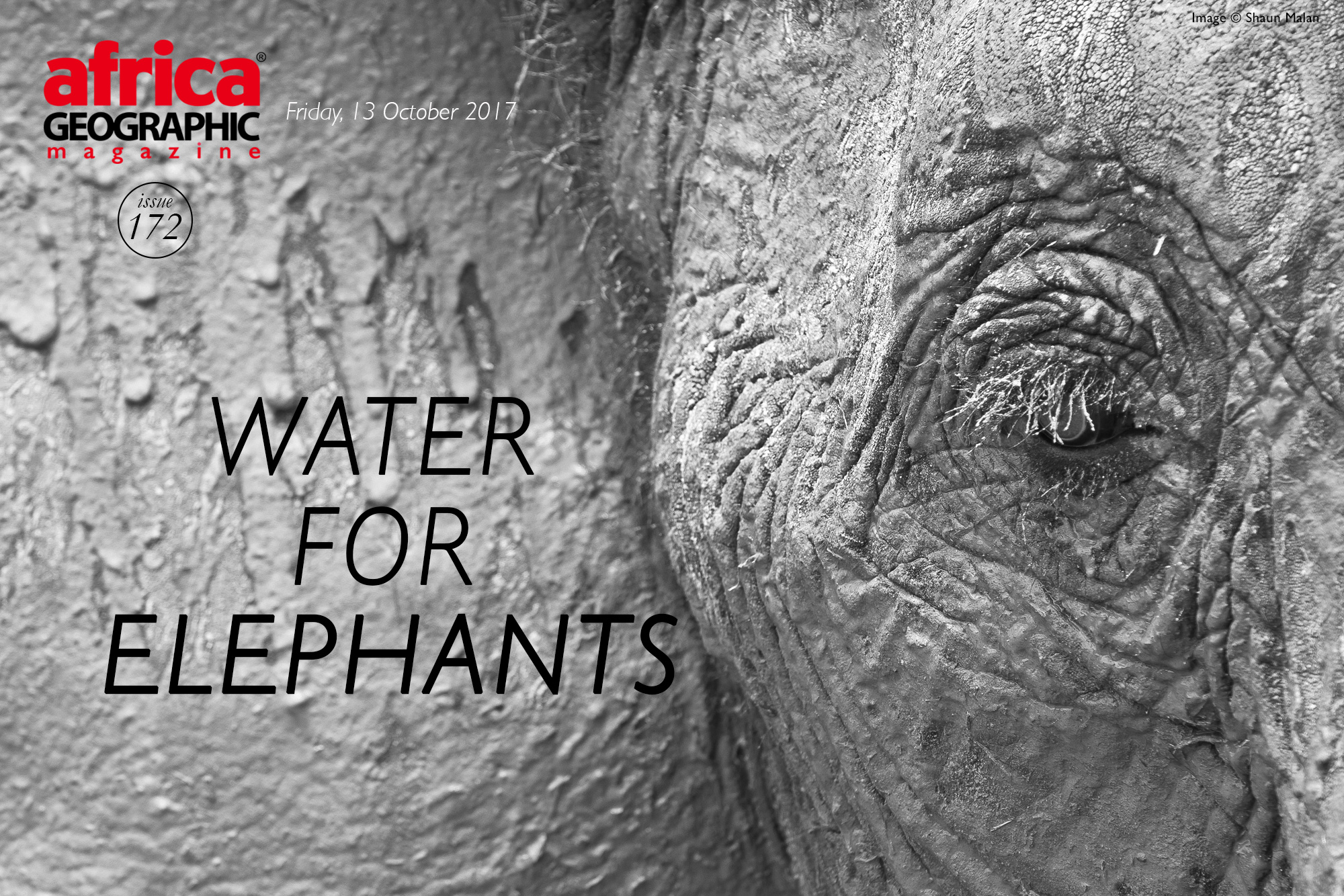
The real elephant problem in Botswana

There is a crisis of elephantine proportions playing out in the dry sandy Kalahari woodlands of eastern Botswana, and a determined family of caring people is caught in the middle of the drama. A friend and I spent a few days with them in September this year and came away determined to help. I hope that my story inspires you to do the same.
Thousands of thirsty elephants utilise the tiny waterhole at Elephant Sands bush lodge and campsite because it is one of a few reliable sources of water in this vast arid landscape – especially during the height of the dry season. The result is often chaos as elephants arrive in their hundreds, exhausted, dehydrated and anxious – with ensuing destruction of infrastructure and property and even injury to younger elephants that get bullied by the massive bulls.

Something must be done. Something is being done. First, though, here is the back story:
The ‘elephant problem.’
We so often hear people espousing that there are “too many elephants” in places such as Chobe, Hwange and Kruger. And the terms ‘elephant damage’ (pushed over trees and damaged property) and the ‘elephant problem’ slip so easily off the tongue and define elephant discussion.
But what does that all mean – how can there be “too many” elephants when elephant populations are collapsing due to industrial-scale poaching and human-wildlife conflict? Do we even understand what we are saying? If we substitute the word ‘elephant’ with ‘human’, would we be closer to the truth? The ‘human problem’.
Examples of damage to property caused by elephants searching for water:
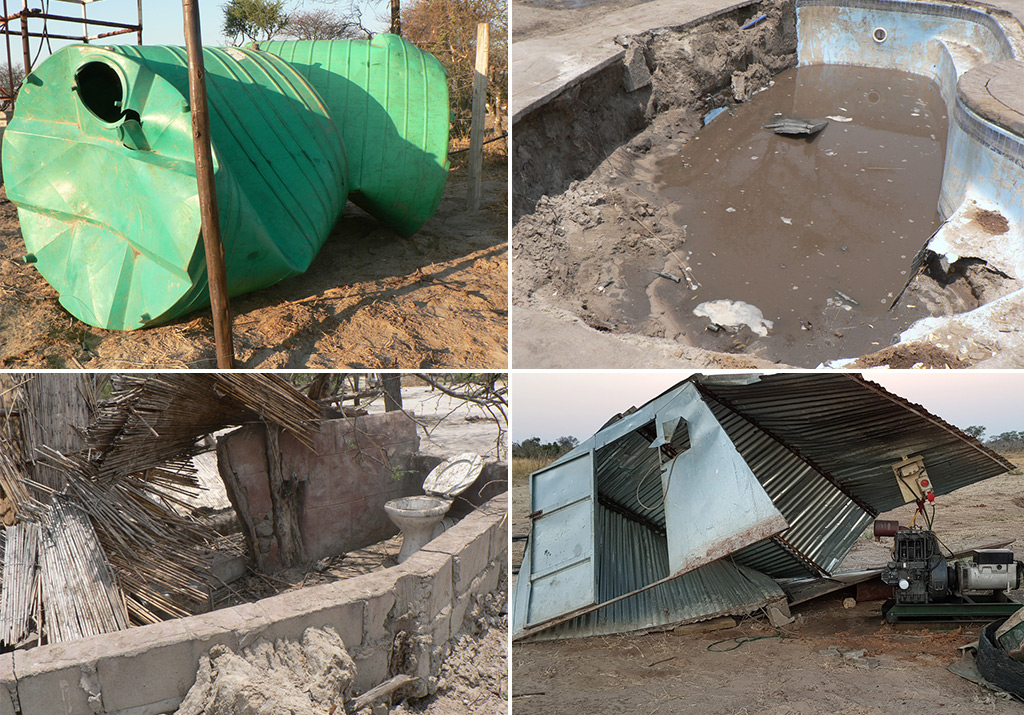
The ‘human problem’
During the rainy seasons elephants (and other migratory species such as zebras and wildebeests) spread out across vast areas, utilising the temporary surface water and seasonal nutritious grasses, buds and leaves. Vast areas of the Kalahari, including Hwange National Park in Zimbabwe, Chobe National Park in Botswana, and the vast salt pans of central Botswana, are utilised in this way.
As surface water dries up, the animals migrate towards permanent water sources such as the Chobe River, which banks used to be covered in thick teak forests. But humans cut down many of the large teak trees during commercial logging operations in the area and turned them into furniture and railway sleepers – compromising the ecosystem. And so, the ‘human problem’ began.
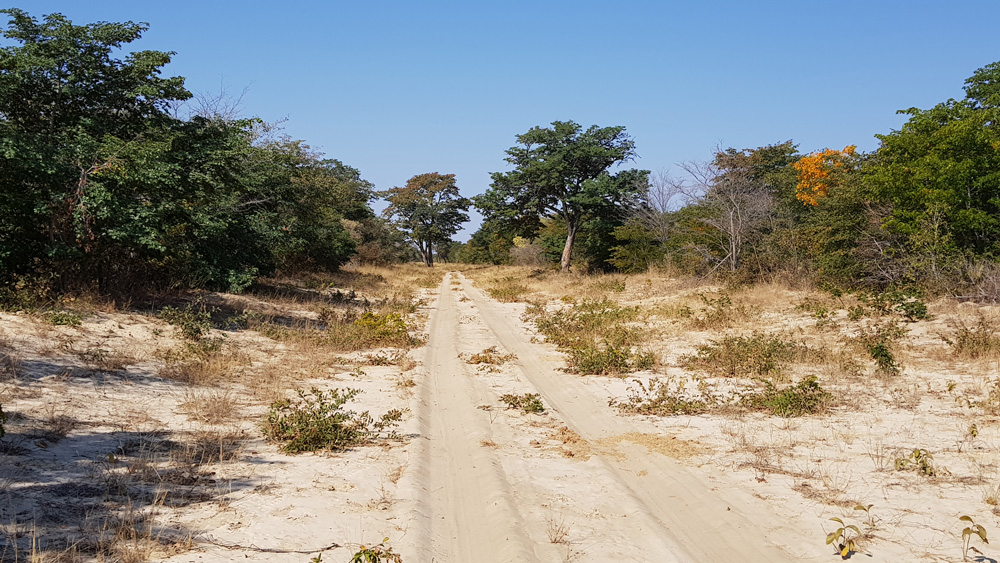
Then we cut through migration routes with tar roads that carry large volumes of massive trucks day and night, and we erected veterinary fences across core ecosystems so vital to migrating species. This is to satisfy European Union beef import rules – is that beefsteak worth the actual cost? And we fenced off the prime areas for farming and other development – which we guard jealously and with brute force – most often with fatal consequences for wildlife.
And international crime syndicates swooped in to set up efficient poaching networks that ruthlessly exterminate wildlife in shocking quantities – forcing elephants to escape the persecution and head for the relative safety of Botswana. Did you know that Botswana now hosts more than one-third of Africa’s surviving elephants?
To protect elephants and other species from these pressures, we created national parks, and we try to keep the animals inside these arbitrarily declared boundaries. Hwange National Park, for example, is primarily made up of deciduous woodland low in nutritional value on Kalahari sand and has very little year-round water. So the park is littered with man-made boreholes, in an attempt to keep the animals in and provide year-round viewing for tourism camps. The boreholes are so ubiquitous to Hwange that they are known as the ‘heartbeat of Hwange’ – due to the diesel put-putting noise. In Hwange’s case, the authorities are so bad at maintaining these boreholes that charities and tourism lodges do so instead.
Trophy hunters add to the pressure on migratory species by picking off prime male elephants, lions and other species as they migrate out of protected areas in search of seasonal water and food or on a mission to secure breeding opportunities so vital for genetic integrity. Africa is littered with protected areas that were formed without thought to seasonal cycles and periods of drought. And these protected cores are surrounded by danger for migrating wildlife.
More and more elephants are crowding onto the already compromised banks of the Chobe River and other areas, where they feel relatively safe, and staying there for longer than the ecosystem can currently sustain.
And so, because the remaining elephants are crammed into smaller and smaller spaces, these special creatures become the ‘elephant problem’.

Trophy hunting concessions
Hunting on Botswana state land was banned in 2014, a brave move by a visionary government that has a clear vision of the future. However, the enormous arid concessions in THIS part of Botswana are not entirely suitable for photographic tourism lodges, which require year-round wildlife sightings to be commercially viable – which in turn requires year-round water availability. When these concessions were closed to hunting they were offered to tourism operators, but the primary focus at the time was on the lucrative concessions in the Okavango Delta and Chobe River areas, and so these vast dry ecosystems remain largely unutilised by the tourism industry.

And, paradoxically perhaps, the boreholes drilled by these trophy hunting operators did provide much-needed water to wildlife in this arid area of Botswana. The boreholes were drilled to attract wildlife to hunter guns, so let’s not pretend that this was a compassionate gesture by the hunters. BUT by many accounts, the legal hunting offtake was not significant, when compared to poaching and human-wildlife conflict pressure elsewhere. When the hunters left the concessions, they took their equipment with them, and so elephants and other species in the area were safe from the guns of hunters, but at risk because of the lack of water…
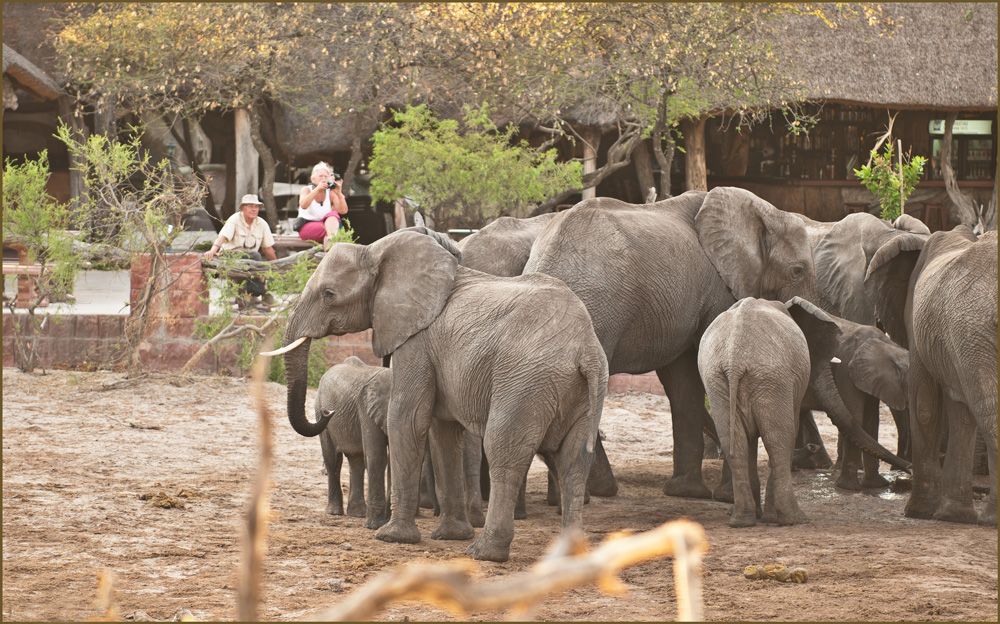
Along came Ben and Marie Moller
At about the time of the hunting ban, Ben and Marie built Elephant Sands lodge and campsite just south of these former hunting concessions – as a retirement hobby. They roped in family members including daughter Saskia and son-in-law Mike Toth, who manages the entire operation. And they dug a borehole to feed a waterhole to attract wildlife to the area. That water source has now become a vital lifeline for elephants from the area, particularly during the dry months, when they gather and jostle in their hundreds.

The problem with having only this one water source for miles around is that during the very dry months when there is no surface water for hundreds of miles, elephants at the waterhole are quite literally fighting for their lives. Many arrive battling to stay upright, after travelling for days in the blistering heat. Tempers become frayed and young elephants and cows are sometimes bullied out of the way and even injured by the massive bulls. And so, the cows go to desperate lengths to access water – including breaking down lodge ablution facilities and borehole equipment. This is not a sustainable situation.
Does Ben take the high road and not meddle with nature by providing water for elephants and other species? We often hear some purists say “don’t play God with nature”. But what does that mean, really, when humans have created the problem in the first place? For Ben and his family, there is no such moral dilemma. Elephants are dying of thirst, and they need help.
Water for Elephants Trust
And so, Water for Elephants Trust was born. In a nutshell, Water for Elephants Trust is working with the authorities to install and maintain as many boreholes over as large an area as possible in this part of eastern Botswana. This will hopefully remove the pressure from current bottleneck areas, and allow the elephants and other wildlife to range over greater areas, putting less strain on food resources. Each borehole will provide water for 800 elephants and countless other species during the dry season. A string of well-maintained boreholes in this area could conceivably help to stitch together the vast Chobe, Okavango Delta, Pans and Hwange ecosystems and help wildlife migrate seasonally, as they should be doing. Visit their Facebook page for regular updates on their progress to ensure elephants remain safe.
And, if you are as moved as I am by the plight of these elephants and wish to make a difference, email Water for Elephants Trust at waterforelephantstrust@gmail.com and offer your support, financial or otherwise.
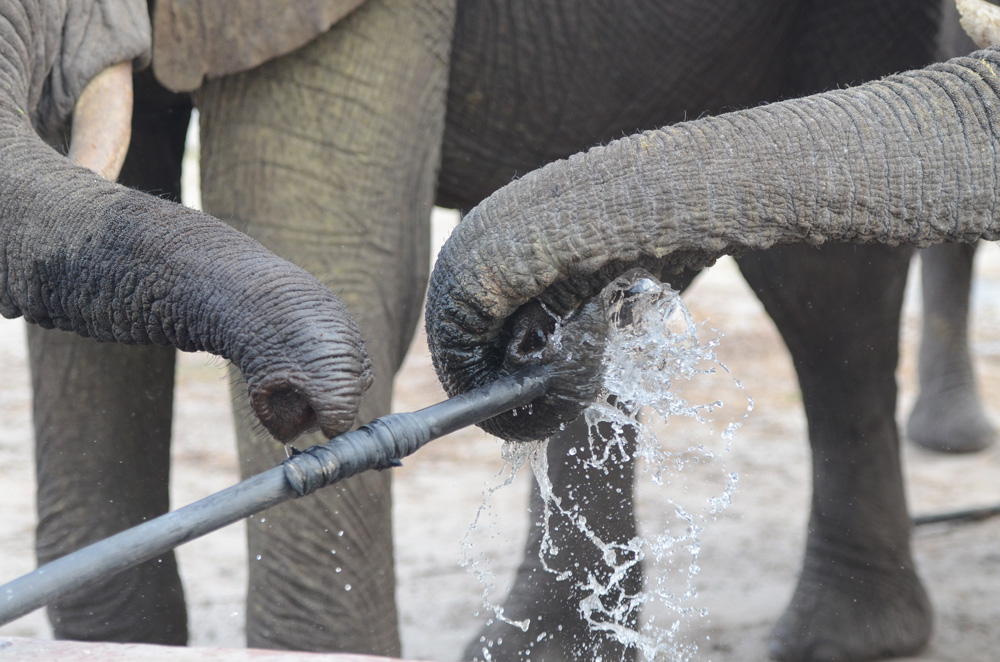
So much drama, so many stories
Life at Elephant Sands is pretty hectic. The team have become used to baby elephants being injured by the jostling adults or arriving dehydrated and unable even to stand. These babies often die – heartbreaking for all concerned. The recent tragic accidental death by electrocution of nine elephants that pushed a power pylon into a pool of water they were drinking from, happened not far south of Elephant Sands – yet another symptom of water-stressed elephants. And then there is Benny, a bull elephant who arrived in camp in August 2015 with a festering foot injury that required treatment.
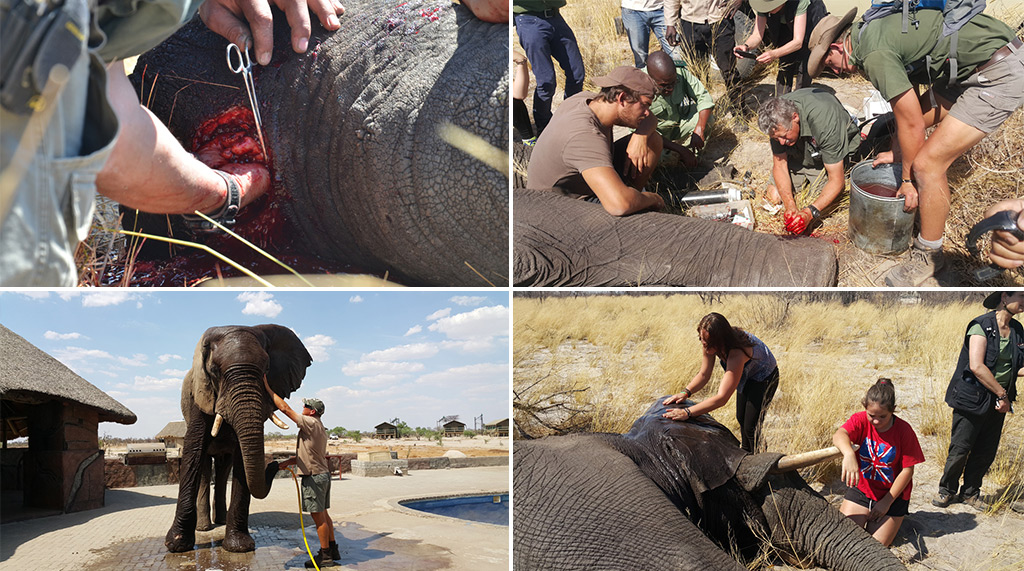
Benny was successfully treated and now visits camp sporadically to seek out Mike Toth, who sometimes obliges with a trunk rub and squirt of clean water from a hosepipe. Bennie even popped in for a visit on 12 August 2017 – World Elephant Day! Read Benny’s full story here.
View this video about Benny and Mike below:
This is about more than just elephants
One consequence of large numbers of elephants congregating at scarce water resources is that other wildlife species are forced out during the melee. Many species are secretive and wary when drinking water, and the pressure of jostling elephants day and night is just too much for them. And so, general wildlife populations have plummeted in many areas since the boreholes were removed – leading to knock-on effects for other species.
During our brief stay in the area, we embarked on a few forays into the former hunting concessions north of Elephant Sands – to inspect boreholes, get a feel for the condition of the veld and to look for wildlife. We saw plenty of elephants and some buffaloes, kudus, impalas and other species. But overall my observation, based on an admittedly short stay, was that there does seem to be a lack of significant numbers of general wildlife species in the area.
On one occasion we disturbed four lions, including two large and magnificent males, one of whom was spitting with anger and malevolence and left us in no doubt that we were not welcome. His loud Harley Davidson-like grumbling continued long after we backed off from his charge and got in the vehicle to withdraw and leave them to their privacy. On another occasion, a flock of tiny black-faced waxbills working the pollen puff balls of an acacia tree reminded me of the detail and interconnectedness of ecosystems such as this.
We also found a lioness that had been flattened by a speeding truck on the main tar road between Kasane and Nata. Africa is a rough and tough place for all that eke out an existence in her wild areas. But we humans have negatively impacted on these vast primal ecosystems, making life even more difficult for many species. We can make things easier for elephants and other species if we support Water for Elephants in their mission to provide much-needed water.![]()
The following photos represent the diversity of this area, sometimes written off as barren and uninteresting, and the many stories to be told.
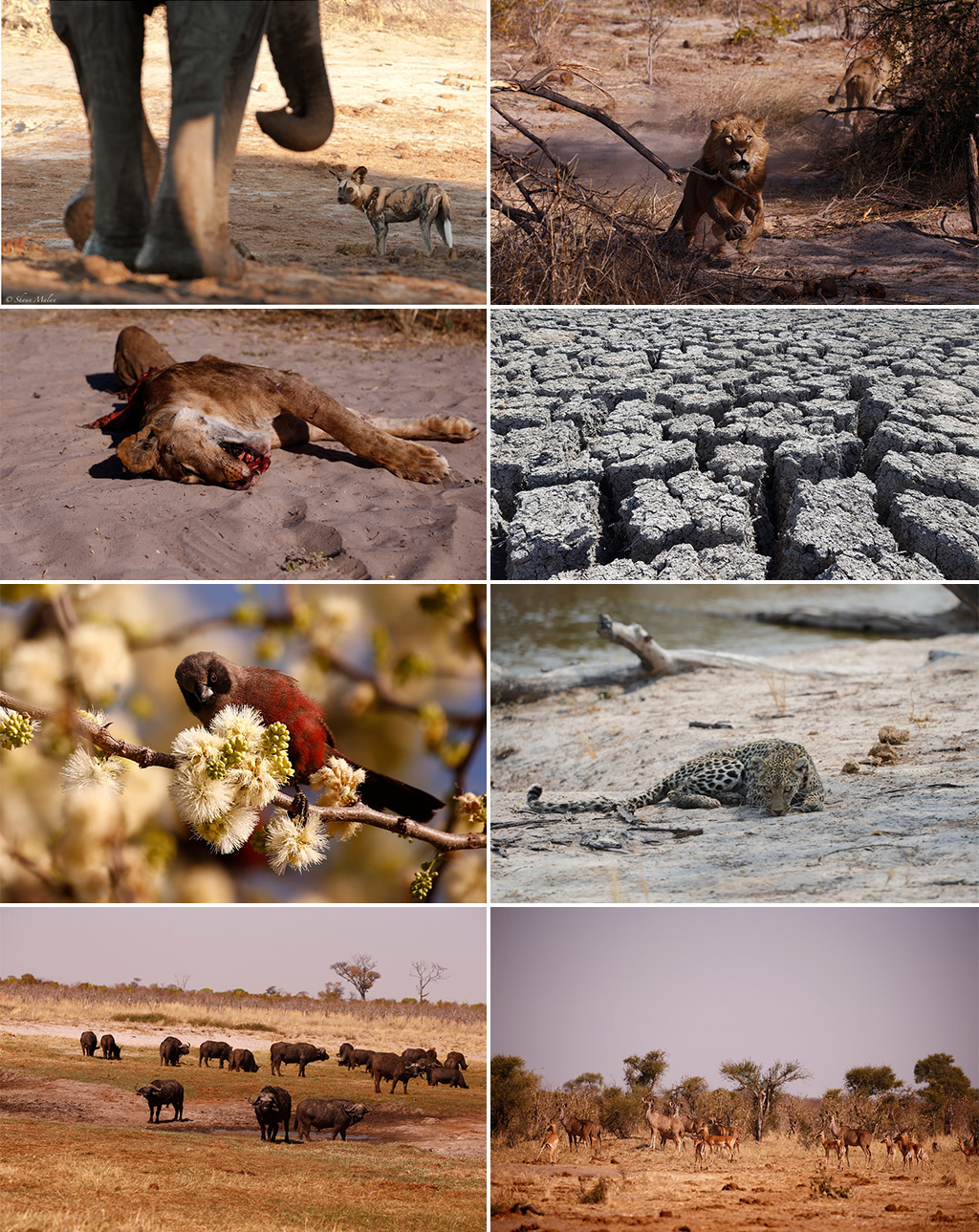
About the author
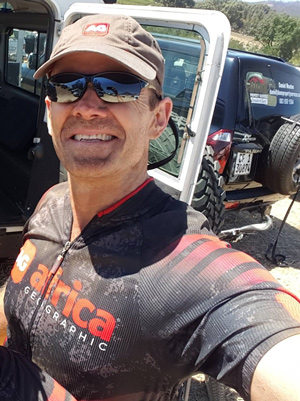 Simon Espley is an African of the digital tribe, a chartered accountant and CEO of Africa Geographic. His travels in Africa are in search of wilderness, real people with interesting stories and elusive birds. He lives in Hoedspruit with his wife Lizz and two Jack Russells, and when not travelling or working, he will be on his mountain bike somewhere out there. His motto is ‘Live for now, have fun, be good, tread lightly and respect others. And embrace change.’
Simon Espley is an African of the digital tribe, a chartered accountant and CEO of Africa Geographic. His travels in Africa are in search of wilderness, real people with interesting stories and elusive birds. He lives in Hoedspruit with his wife Lizz and two Jack Russells, and when not travelling or working, he will be on his mountain bike somewhere out there. His motto is ‘Live for now, have fun, be good, tread lightly and respect others. And embrace change.’

To comment on this story: Login (or sign up) to our app here - it's a troll-free safe place 🙂.![]()




